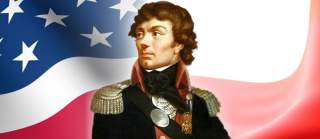Meet Thaddeus Kosciusko, the Polish Engineer Fought Both in the American Revolution and for His Homeland
America needed men like him.
Substantially ticked off, Kosciusko slips by Tsarist patrols and enters Krakow in March of 1794. On March 24, he casually kicks off an uprising from the Main Square and begins building an army of volunteers, including untrained peasants as well as former members of the regular army. Throughout the spring and summer, he wages war against Russian forces, winning small victories but nothing large enough to turn the tide. Prussia of course hops in on this thing, and now Kosciusko is faced with a two-front war. On October 10, he is wounded and captured. This pretty much takes the heart out of the uprising, and Russia and Prussia annex what’s left of Poland – ending the Polish state for the next 123 years.
Fortunately for Kosciusko, Catherine the Great kicks the bucket in November of 1796, and Tsar Paul I frees Kosciusko and pardons him. Kosciusko calls it quits on this whole European thing and heads back to the U.S. in 1797. Here, the Federalist U.S. government gives him a lukewarm welcome because of his association with the French Revolution. However, he strikes up a firm friendship with Thomas Jefferson. But just one year later, Kosciusko is back in France, having received word that the Poles are siding with Napoleon to try to kick Prussia and Russia out and regain sovereignty. Kosciusko leaves his estate with Jefferson, with the express desire that his money go to the freeing of American slaves – including Jefferson’s – and their education. Predictably, Jefferson won’t do this. The bequest gets held up in courts – including the U.S. Supreme Court – until 1856. Go figure.
Meanwhile, Kosciusko arrives in France to find that the French government and Napoleon really don’t care about Polish sovereignty at all. After the fall of Bonaparte in 1815, Kosciusko travels to Russia to negotiate with the Tsar for an independent Polish state, with borders restored to their 1792 status, as well as social reforms. The Tsar instead creates the Kingdom of Poland, a tiny vassal state that Kosciusko descries as “a joke.” Thoroughly frustrated, Kosciusko moves to Switzerland. In 1817, he attempts to emancipate the peasants on his remaining lands back home, but the Tsar refuses to allow it. In obstinate pique, Kosciusko dies on October 15, 1817.
As his retribution to the Tsar, the Federalists, and Napoleon, Kosciusko will be one of the most well-beloved and memorialized Poles in history, with monuments to him in his native Poland – he has his own mound in Krakow, composed of earth from the battlefields where he fought – bridges named for him in Albany and New York City, his home in Philadelphia becoming the smallest U.S. National Park, and a museum at his residence in Switzerland. There are statues of him in Washington, D.C., Krakow, Lodz, Boston, West Point, Philadelphia, Detroit, Chicago, Milwaukee, Cleveland, Belarus, and Solothurn, Switzerland. He also is the namesake for the tallest mountain in Australia.
He’s one of many foreign volunteers without whom the U.S. probably wouldn’t exist. He’s also unique in that he was a social reformer who was an abolitionist before it was cool. The dude lived a metal life and I have no idea why there hasn’t been a movie made about him.
About the Author: Angry Staff Officer is an Army engineer officer who is adrift in a sea of doctrine and staff operations and uses writing as a means to retain his sanity. He also collaborates on a podcast with Adin Dobkin entitled War Stories, which examines key moments in the history of warfare. Support this blog’s Patreon here.
This article by The Angry Staff Officer originally appeared on The Angry Staff Officer in 2019.
Check out these other articles from The Angry Staff Officer:
Marvel-ling at the Pentagon: Force Design in the MCU
The Wakandan Civil War: A Profile in State Reconstruction
Military Lessons Learned from the Battle of Wakanda
Image: Kosciuszko Foundation.

